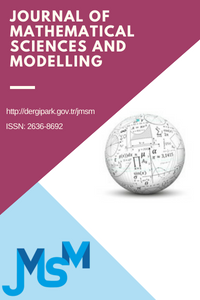A Mathematical Note on the Evolutionary Competitiveness of the Trisexual Nematode Auanema Rhodensis
A Mathematical Note on the Evolutionary Competitiveness of the Trisexual Nematode Auanema Rhodensis
Auanema Rhodensis, bifurcation global dynamics,
___
- [1] J. Chaudhuri, V. Kache, A. Pires-daSilva, Regulation of sexual plasticity in a nematode that produces males, females, and hermaphrodites, Current Biology, 21 (2011), 1548-1551,
- [2] T. Hale, This Trisexual Worm Bends the Rules of Typical Genetics, IFL Science, 19/ 01/ 2018 (2018), http://www.iflscience.com/ plants-and-animals/a-trisexual-worm-bends-the-rules-of-typical-genetics/.
- [3] D.C. Shakes, B.J. Neva, H. Huynh, J. Chaudhuri, A. Pires-daSilva, Asymmetric spermatocyte division as a mechanism for controlling sex ratios, Nature Communications, 2(157) (2011).
- [4] S. Tandonnet, M.C. Farrell, G.D. Koutsovoulos, M.L. Blaxter, M. Parihar, P.L. Sadler, D.C. Shakes, A. Pires-daSilva, Sex- and gamete-specific patterns of X chromosome segregation in a trioecious nematode, Current Biology, 28 (2018), 93-99.
- [5] N. Kanzaki, K. Kiontke, R. Tanaka, Y. Hirooka, A. Schwarz, T. M¨uller-Reichert, J. Chaudhuri, A. Pires-daSilva, Description of two three-gendered nematode species in the new genus Auanema (Rhabditina) that are models for reproductive mode evolution, Scientific Reports, 7 (2017), 11135.
- [6] E. Garibaldi, M. Sobottka, A nonsmooth two-sex population model, Mathematical Biosciences, 253 (2014), 1-10.
- [7] K.P. Hadeler, R. Waldst¨atter, A. W¨orz-Busekros, Models for pair formation in bisexual populations, J. Math. Biol., 26 (1988), 635-649.
- [8] D.G. Kendall, Stochastic processes and population growth, J. R. Stat. Soc. Ser. B Stat. Methodol., 11 (1949), 230-264.
- [9] D.J. Rankin, H. Kokko, Do males matter? The role of males in population dynamics, Oikos, 116 (2007), 335-348.
- [10] J.D. Murray, Mathematical Biology I. An Introduction, 3rd ed., Springer, 2002.
- [11] J.D. Murray, Mathematical Biology II. Spatial Models and Biomedical Applications, 3rd ed., Springer, 2003.
- [12] F. Rupp, J. Scheurle, Analysis of a Mathematical Model for Jellyfish Blooms and the Cambric Fish Invasion, Dynamical Systems and Differential Equations, DCDS Supplement 2013 Proceedings of the 9th AIMS International Conference (Orlando, USA) (2013), 663-672.
- [13] F. Rupp, J. Scheurle, The dynamics of the jellyfish Joyride: Mathematical discussion of the causes to blooming, Math. Methods Appl. Sci., 38(16) (2015), 3408-3420.
- [14] E.C. Buehler, S. Das, J.F. Cully Jr., Equilibrium and extinction in a trisexual diploid mating system: An investigation, K. Deb (editor), Genetic and Evolutionary Computation – GECCO 2004, Lecture Notes in Computer Science, vol 3102, Springer, Berlin, Heidelberg, 2004.
- [15] E.C. Buehler, S. Das, J.F. Cully Jr., Equilibrium and Extinction in a Trisexual Diploid Mating System, 2004.
- [16] K. Jaffe, The dynamics of the evolution of sex: Why the sexes are, in fact, always two?, Interciencia, 21(6) (1996), 259-267.
- ISSN: 2636-8692
- Yayın Aralığı: Yılda 3 Sayı
- Başlangıç: 2018
- Yayıncı: Mahmut AKYİĞİT
Energy-Momentum Distribution for Magnetically Charged Black Hole Metric
Farasat SHAMİR, Rida EJAZ, Mushtaq AHMAD
A Mathematical Note on the Evolutionary Competitiveness of the Trisexual Nematode Auanema Rhodensis
Domination Edge Integrity of Corona Products of Pn with Pm,Cm,K1,m
$f$-Asymptotically $\mathcal{I}_{\sigma\theta}$-Equivalence of Real Sequences
Modified Block-Pulse Functions Scheme for Solve of Two-Dimensional Stochastic Integral Equations
